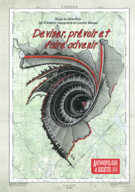Abstracts
Résumé
La divination connaît une hausse de sa popularité au Japon. Que ce soit les formes liées aux religions et doctrines plus anciennes, comme le shintô, le bouddhisme ou le daoïsme, comme acheter des papiers sur lesquels on lit son avenir dans les temples et sanctuaires, ou parler aux esprits, ou lire l’avenir dans les lignes de la main ou des bâtonnets de bambou, ou bien dans des formes plus récentes, comme l’astrologie occidentale, et plus ludiques, comme la divination à l’aide d’animaux, que ce soit dans la rue, dans des foires ou dans des centres d’achat, à la télévision ou sur Internet, la divination gagne en popularité. Ce sont surtout des femmes qui pratiquent la divination et les jeunes femmes qui en sont les plus importantes consommatrices.
Mots clés:
- Bernier,
- Japon,
- divination,
- religion,
- esprits,
- femmes,
- jeu
Abstract
Divination has seen a surge of popularity in Japan recently. Whether based on ancient religion and doctrines, such as Shintô, Buddhism or Daoism, for example buying papers with your future written on them in Shintô shrines or Buddhist temples, talking to spirits, read the future in the line of the hand or on bamboo sticks, or more popular forms, such as western astrology, or more fun, such as animal divination, be it in street stalls or in symposium or in shopping centers, or on television or Internet, divination is doing well. Women are the main specialists and are the main consumers of divination, especially for this last case, young women between 15 and 30 years of age.
Keywords:
- Bernier,
- Japan,
- Divination,
- Religion,
- Spirits,
- Women,
- Games
Resumen
La adivinación aumenta en popularidad en Japón. Ya sean las formas vinculadas con las religiones y las doctrinas más antiguas, como el sintoísmo, el budismo o el taoísmo, como comprar papeles en donde se lee el futuro en los templos y santuarios, o hablar con los espíritus, o leer el porvenir en las líneas de la mano o en los bastoncitos en bambú, o bien en sus formas más recientes, como la astrología occidental y las más lúdicas, como la adivinación con ayuda de animales, ya sea en la calle o en las ferias o en los centros comerciales, en la televisión o en Internet, la adivinación gana popularidad. Son sobre todo las mujeres quienes practican la adivinación y las jóvenes mujeres quienes son las más importantes consumidoras.
Palabras clave:
- Bernier,
- Japón,
- adivinación,
- religión,
- espíritus,
- mujeres,
- juego
Appendices
Références
- Bernier B., 1975, Breaking the Cosmic Circle. Folk Religion in a Japanese Village. Ithaca, Cornell University East Asia Papers No 5.
- Bernier B., 2009, Le Japon au travail. Montréal, Les Presses de l’Université de Montréal.
- Bernier B., 2010, « La transcendance chez Watsuji » : 446-482, in J. Tremblay (dir.), Philosophes japonais contemporains. Montréal, Les Presses de l’Université de Montréal.
- Bernier B., 2014a, « Youth Labor » : 37-50, in H. Itoh et B. Bernier (dir.), Japanese Youth in the Conservative Elite Society : Essays on the Liberal Young Super-Achievers. Lewiston, The Edwin Mellen Press.
- Bernier B., 2014b, « What Do Young Japanese Women Think of Marriage, Work and Career ? » : 121-140, in H. Itoh et B. Bernier (dir.), Japanese Youth in the Conservative Elite Society : Essays on the Liberal Young Super-Achievers. Lewiston, The Edwin Mellen Press.
- Bernier B. et H. Itoh, 2014, « Young Women » : 103-120, in H. Itoh et B. Bernier (dir.), Japanese Youth in the Conservative Elite Society : Essays on the Liberal Young Super-Achievers. Lewiston, The Edwin Mellen Press.
- Brown R.L., 1972, The Magical Oracles of Japan. How to Divine Your Future with These Thousand-Year-Old Systems. Londres, L.N. Fowler and Co.
- Gilhooly R., 2001, « Divination Business Thriving, for the Foreseeable Future », The Japan Times, 16 septembre 2001, disponible sur Internet (https://www.japantimes.co.jp/community/2001/09/16/general/divination-business-thriving-for-the-foreseeable-future/) le 28 mai 2018.
- Granet M., 1968 [1934], La pensée chinoise. Paris, Éditions Albin Michel.
- Hori I., 1968, Folk Religion in Japan. Continuity and Change. Chicago, The University of Chicago Press.
- Kubo K., 1999, Dôbutsu uranai (動物占い. La divination à l’aide des animaux). Tokyo, Shôgakkan.
- Kuyôgi S., 2001, Abeno Seimei hiden : Onmyôji « shikigami » uranai (安倍晴明秘伝・陰陽師式神占い. Le secret de Abeno Seimei. La divination du maître du Onmyôdô à l’aide de son kami personnel). Tokyo, Futami Shobô.
- Lao Tzu, 2007 [ca 600 av. J.-C.], Tao Te Ching. Boston, Londres, Shambhala Publications.
- Lock M., 1990, « Les trésors perdus. Ordre/désordre social et récits de révolte des adolescents japonais », Anthropologie et Sociétés, 14, 3 : 77-96, disponible sur Internet (http://id.erudit.org/iderudit/015144ar) le 10 avril 2018.
- Miller L., 2014, « The Divination Arts in Girl Culture » : 247-267, in S. Kawano, G.S. Roberts et S.O. Long (dir.), Capturing Contemporary Japan. Differentiation and Uncertainty. Honolulu, University of Hawai’i Press.
- Reader I., 1991, Religion in Contemporary Japan. Honolulu, University of Hawai’i Press.
- Rocher A., 2011, « Religions et traditions populaires du Japon », Annuaire de l’École pratique des hautes études (EPHE), Section des sciences religieuses, 118 : 45-49, disponible sur Internet (https://journals.openedition.org/asr/936) le 10 avril 2018.
- Schattschneider E., 2003, Immortal Wishes : Labor and Transcendence on a Japanese Sacred Mountain. Durham, Duke University Press.
- Suzuki K., 1995, « Divination in Contemporary Japan : A General Overview and an Analysis of Survey Results », Japanese Journal of Religious Studies, 22, 3-4 : 249-266, disponible sur Internet (doi : 10.18874/jjrs.22.3-4.1995.249-266) le 10 avril 2018.


 10.7202/015144ar
10.7202/015144ar